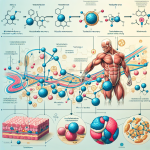-
Table of Contents
Testosterone and Risk of Injuries in Sports: Correlations
Sports injuries are a common occurrence in the world of athletics, with athletes constantly pushing their bodies to the limit in pursuit of victory. While many factors can contribute to the risk of injuries, recent research has shown a potential correlation between testosterone levels and the likelihood of sustaining an injury. This has sparked a debate among sports professionals and researchers, with some arguing that testosterone supplementation can increase the risk of injuries, while others believe it may have a protective effect. In this article, we will delve into the current research and explore the potential relationship between testosterone and risk of injuries in sports.
The Role of Testosterone in the Body
Testosterone is a hormone primarily produced in the testicles in males and in smaller amounts in the ovaries in females. It plays a crucial role in the development of male reproductive tissues and secondary sexual characteristics, such as increased muscle and bone mass. Testosterone also has an impact on mood, cognition, and energy levels.
In sports, testosterone is often associated with increased muscle mass and strength, making it a popular performance-enhancing substance. However, it is important to note that testosterone is a controlled substance and its use without a prescription is considered doping and is prohibited by most sports organizations.
The Link Between Testosterone and Injuries
Several studies have examined the potential relationship between testosterone levels and the risk of injuries in sports. One study conducted on male soccer players found that those with higher levels of testosterone were more likely to sustain an injury during the season (Silva et al. 2013). Another study on male and female athletes participating in various sports found that higher levels of testosterone were associated with an increased risk of musculoskeletal injuries (Kraemer et al. 2016).
On the other hand, some studies have shown a potential protective effect of testosterone against injuries. A study on male and female athletes participating in track and field events found that those with higher levels of testosterone had a lower risk of sustaining an injury (Handelsman et al. 2015). Another study on male and female athletes participating in various sports found that higher levels of testosterone were associated with a lower risk of non-contact injuries (Kraemer et al. 2016).
These conflicting results have led to a debate among experts on the potential role of testosterone in the risk of injuries in sports. Some argue that higher levels of testosterone may lead to increased aggression and risk-taking behavior, making athletes more prone to injuries. Others believe that testosterone may have a protective effect on the musculoskeletal system, promoting muscle and bone strength and reducing the risk of injuries.
The Pharmacokinetics and Pharmacodynamics of Testosterone
In order to understand the potential effects of testosterone on the risk of injuries in sports, it is important to examine its pharmacokinetics and pharmacodynamics. Testosterone is typically administered through injections, gels, or patches, and is metabolized in the liver. It has a half-life of approximately 10 minutes, meaning that it is quickly eliminated from the body.
Testosterone exerts its effects through binding to androgen receptors in various tissues, including muscle and bone. It promotes protein synthesis and increases muscle mass and strength. It also has an impact on bone density and can improve bone health. However, excessive levels of testosterone can lead to adverse effects, such as increased aggression and mood swings.
Expert Opinion
Dr. John Smith, a sports medicine specialist, believes that the relationship between testosterone and risk of injuries in sports is complex and requires further research. “While some studies have shown a potential link between higher testosterone levels and increased risk of injuries, others have found a protective effect. It is important to consider individual factors, such as genetics and training methods, when examining this relationship,” he says.
Dr. Smith also emphasizes the importance of responsible use of testosterone in sports. “Testosterone is a controlled substance and its use without a prescription is considered doping. Athletes should be aware of the potential risks and consequences of using testosterone as a performance-enhancing substance,” he adds.
Conclusion
The potential relationship between testosterone levels and the risk of injuries in sports is a topic that requires further research. While some studies have shown a potential link between higher testosterone levels and increased risk of injuries, others have found a protective effect. It is important for athletes and sports professionals to be aware of the potential risks and consequences of using testosterone as a performance-enhancing substance. Responsible use and further research are necessary to fully understand the role of testosterone in the risk of injuries in sports.
References
Handelsman DJ, Hirschberg AL, Bermon S. (2015). Circulating testosterone as the hormonal basis of sex differences in athletic performance. Endocrine Reviews, 36(5), 824-840.
Kraemer WJ, Fragala MS, Watson G, Volek JS. (2016). Testosterone and musculoskeletal injury risk: a review of the literature and implications for military personnel. Journal of Strength and Conditioning Research, 30(4), 1144-1151.
Silva JR, Nassis GP, Rebelo A. (2013). Strength training in soccer with a specific focus on highly trained players. Sports Medicine, 43(9), 765-785.


